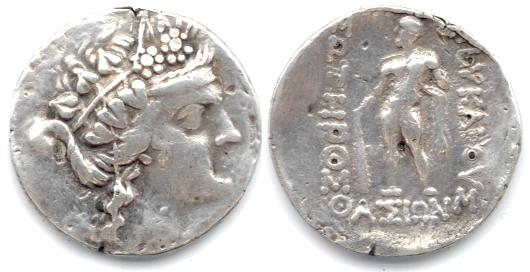
Fouree Thasos Tetradrachm

Enlargement of Obverse
Enlargement of Reverse
This appears to be an ancient forgery of a Thasos tetradrachm, after 148 BC. Reference Sear (Greek) #1635.
WEIGHT:
15.87 grams
SIZE:
32.0 x 32.5 mm
STYLE:
Good
MANUFACTURE:
This is clearly a die struck fouree (plated coin)
FIRST IMPRESSION:
Fair
CHARACTERISTICS: A closer examination shows the following features:
| 3) |
The surface has a slight ungulation to it that is not typical of official mint coins, but suggests that the core material inside is corroding and expanding below the silver sheet. Unfortunately this is a feature not easily shown on an image, and we have not been able to do so. |
| 4) |
On a number of places on the reverse there are circular areas where small amounts of the core are exposed. They generally occur on points where the metal was highly stressed during striking and are thus were the sheeting is probably stretched thinnest and has worn through. A particularly good example is visible in the bottom right corner. |
| 5) |
There is one spot on the reverse, with a very similar round hole exposing part of the core, just between Heracles' legs. The metal at this point is not heavily stressed, and it is a protected area that would not have received a lot of wear. The hole here is also very round, which leaves me to believe this might have been a test punch put there by someone in antiquity that might have suspected this is a fouree. There is no way of knowing if this punch actually made that determination, but the amount of wear on the coin clearly shows that it remained in circulation for some time before it was discovered (if it ever was discovered in ancient times). |
| 6) |
The weight is only slightly low, and still within the acceptable standards of a Thasos tetradrachm of this type. For this issue style is a bit of a problem. These coins were generally struck from poorly engraved official dies, and they were heavily imitated in ancient times in poor style but solid silver. The style of this example is actually better than some of the poorer coins that are thought to be struck from official dies. |
RELATIVE DANGER
DEALER
very low
COLLECTOR
EXPERIENCED
low
NOVICE
moderate to high
Everything about this coin clearly shows that it is of ancient origin, but dealers and collectors used to looking at ancient fouree will probably recognize it immediately for what it is. However, the weight and style are very good, and a novice collector who is not experienced with these might purchase it not realizing that it is not a product of the official mint (several examples of this happening with other fouree have come to light recently). As a fouree it still has a reasonable value was a collectible in it's own right, although not as high as an official mint example in the same grade would be.
Back to examples of fakes.
Top of Page
| |

Copyright © 1997-2015 R & T Enterprises Ltd.
|
 |
|



